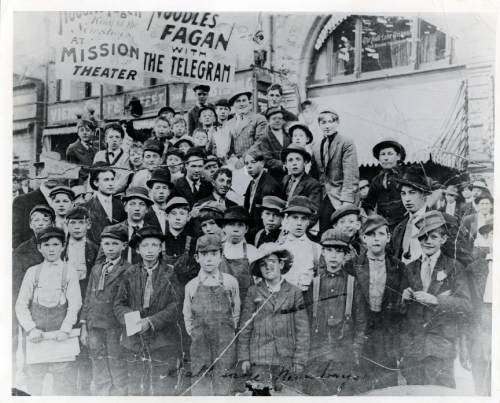Extra! Extra! Read all about it! Newsies go on strike!
July 20, 1899, New York City: Newsboys Strike of 1899 Begins
The newsboys (better known as newsies) of New York, New York hocked newspapers for publishers like the New York World and the New York Journal went on strike after a prices increased by 10 cents. How this system worked was the newsies would buy a stack of newspapers (stacked by one hundred) for 50 cents and sold them to the public for a penny. The papers got together and decided to increase prices from 50 cents to 60, meaning newsies had to sell 10 more papers to maintain their already poor wages. Part of this issue was that any unsold papers could not be bought back by the papers, so the boys had to work even harder to sell their papers, which was already a daunting task. To these boys, there was nothing left to do but strike. It should also be mentioned that these boys were just that boys; some of which were no older than 18 years old.
There had been small newsboys strikes before, but nothing compared to this. The price increase began during the Spanish-American War, and wasn't a big deal. War headlines sold like hot cakes, so the newsies had no issues making their profit. The problem started after the war. Some papers went back to their original prices, but publishers Joseph Pulitzer and William Randolph Hearst (publishers for The Evening World and The New York Evening Journal) kept prices at the increased level. The newsboys had to start competing with each other instead of working with each other. It didn't take long for the newsies to realize how hard the price increase was for them. Things began to escalate when the newsies realized they weren't always being sold 100 papers, but actually less than that, meaning they could never make their original profit.
Newsies from all over the city met to unionize, they demanded that the prices of bundles be reduced back to their original 50 cents per bundle and let it be known that they would not sell the Journal or World until the prices changed. After announcing the official strike had begun, many began to ask advertisers to stop supporting the two monopolies. Newsies encouraged consumers to buy from any other paper but the Hearst and Pulitzer's. The strike was dangerous for these boys, they became violent if newsies found out others were selling instead of striking, some even went to jail. After several days of fighting and the papers feeling the burn, they eventually settled on not lowering costs of bundles, but agreeing to buy back any unsold papers.
Newsies Impact
A little over 112 years after the newsboys strike, the Disney musical "Newsies" hit the great white way. Newsies: The Broadway Musical told the story of the newsboys strike, it followed the leader Jack Kelly (a representation of Kid Blink, the real-life leader of this strike) and his fight for himself and his fellow newsies. Like any entertainment adaption, some extra details were included that did not happen during the actual strike (for example, in the musical Jack Kelly falls in love with Pulitzer's daughter which helps them take down the publisher, which definitely didn't happen in real life). This Disney musical started bringing life to the history that many would never hear about, including a young hopeful journalist to be; me.
Works Cited:
https://blogs.shu.edu/nyc-history/2017/11/07/newspaper-strike-of-1900/
https://allthatsinteresting.com/newsboy-strike-of-1899
https://www.grunge.com/313557/the-untold-story-of-the-newsboys-strike-of-1899/






No comments:
Post a Comment